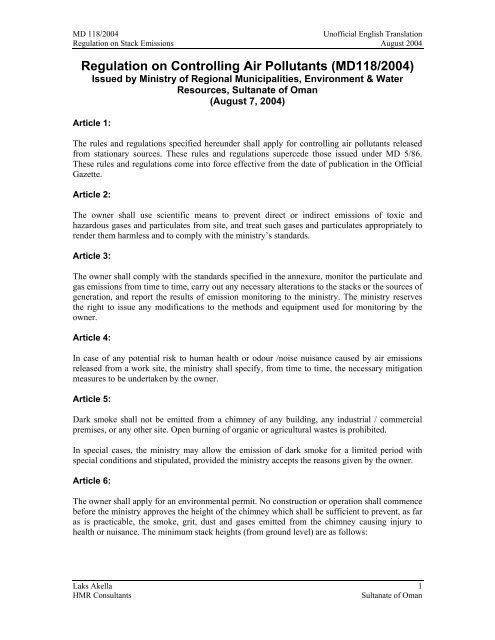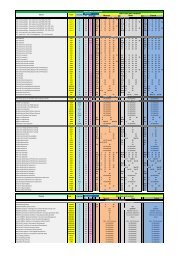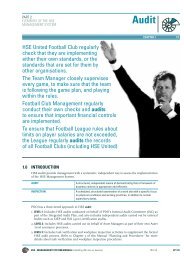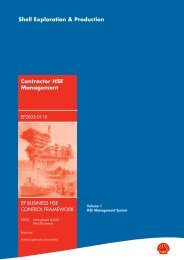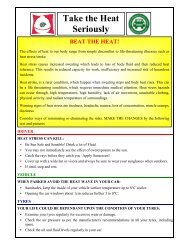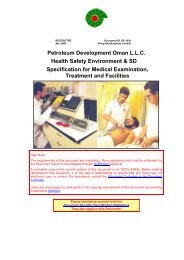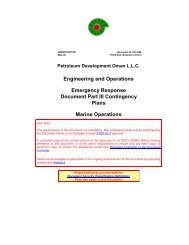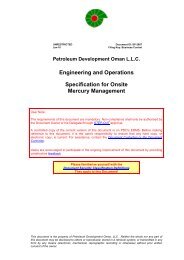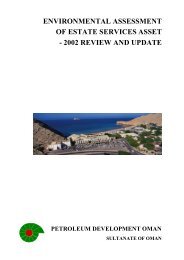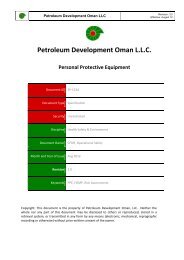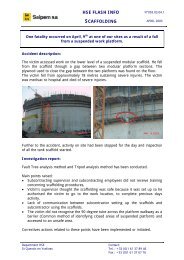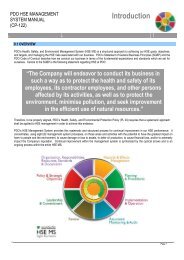Air Pollution Control from Stationary Sources - PDO
Air Pollution Control from Stationary Sources - PDO
Air Pollution Control from Stationary Sources - PDO
You also want an ePaper? Increase the reach of your titles
YUMPU automatically turns print PDFs into web optimized ePapers that Google loves.
MD 118/2004<br />
Unofficial English Translation<br />
Regulation on Stack Emissions August 2004<br />
Regulation on <strong>Control</strong>ling <strong>Air</strong> Pollutants (MD118/2004)<br />
Issued by Ministry of Regional Municipalities, Environment & Water<br />
Resources, Sultanate of Oman<br />
(August 7, 2004)<br />
Article 1:<br />
The rules and regulations specified hereunder shall apply for controlling air pollutants released<br />
<strong>from</strong> stationary sources. These rules and regulations supercede those issued under MD 5/86.<br />
These rules and regulations come into force effective <strong>from</strong> the date of publication in the Official<br />
Gazette.<br />
Article 2:<br />
The owner shall use scientific means to prevent direct or indirect emissions of toxic and<br />
hazardous gases and particulates <strong>from</strong> site, and treat such gases and particulates appropriately to<br />
render them harmless and to comply with the ministry’s standards.<br />
Article 3:<br />
The owner shall comply with the standards specified in the annexure, monitor the particulate and<br />
gas emissions <strong>from</strong> time to time, carry out any necessary alterations to the stacks or the sources of<br />
generation, and report the results of emission monitoring to the ministry. The ministry reserves<br />
the right to issue any modifications to the methods and equipment used for monitoring by the<br />
owner.<br />
Article 4:<br />
In case of any potential risk to human health or odour /noise nuisance caused by air emissions<br />
released <strong>from</strong> a work site, the ministry shall specify, <strong>from</strong> time to time, the necessary mitigation<br />
measures to be undertaken by the owner.<br />
Article 5:<br />
Dark smoke shall not be emitted <strong>from</strong> a chimney of any building, any industrial / commercial<br />
premises, or any other site. Open burning of organic or agricultural wastes is prohibited.<br />
In special cases, the ministry may allow the emission of dark smoke for a limited period with<br />
special conditions and stipulated, provided the ministry accepts the reasons given by the owner.<br />
Article 6:<br />
The owner shall apply for an environmental permit. No construction or operation shall commence<br />
before the ministry approves the height of the chimney which shall be sufficient to prevent, as far<br />
as is practicable, the smoke, grit, dust and gases emitted <strong>from</strong> the chimney causing injury to<br />
health or nuisance. The minimum stack heights (<strong>from</strong> ground level) are as follows:<br />
Laks Akella 1<br />
HMR Consultants<br />
Sultanate of Oman
MD 118/2004<br />
Unofficial English Translation<br />
Regulation on Stack Emissions August 2004<br />
Power Plants<br />
Plants generated by natural gas<br />
Plants generated by diesel oil<br />
Boilers<br />
Boilers generated by natural gas<br />
Boilers generated by diesel oil<br />
Furnaces<br />
Cement manufacturing ovens<br />
Ceramic manufacturing ovens<br />
Melting Kilns<br />
Metallic and non-Metallic Elements<br />
Incinerators<br />
Medical, municipal and industrial waste incinerator<br />
26 m<br />
35 m<br />
15 m<br />
20 m<br />
40 m<br />
20 m<br />
45 m<br />
15-20 m<br />
For other categories, the stack height shall be at least 2.5 times the height of the tallest building<br />
around the facility.<br />
Article 7:<br />
The permit to operate shall be issued for a period of three years, which can be renewed for a<br />
similar period or longer. Application for renewal shall be made at one month before the expiry<br />
date. A fee of twenty-five (25) Omani Rials is to be paid for the permit application or renewal.<br />
In case of late renewal of the permit, a five (5) Omani Rial fine is to be paid for every month (or<br />
part of a month) with the maximum limit of one hundred (100) Omani Rials.<br />
Article 8:<br />
Environmental Inspectors <strong>from</strong> the ministry are authorized to enter any work site at any time in<br />
order to inspect any process emitting noxious or offensive substances, to check the efficiency of<br />
pollution control systems and to monitor / test the emission quantities and quality.<br />
Article 9:<br />
The owner or his representative shall permit the Environmental Inspectors to enter the work site,<br />
inspect the facilities and carry out the necessary tests. On written request <strong>from</strong> the Inspectors, the<br />
owner or his representative shall provide the necessary flow sheets and layout plans, which shall<br />
be maintained confidential by the ministry.<br />
Article 10:<br />
The owner shall notify in writing to the ministry of any changes made with respect to the<br />
ownership or the manufacturing process.<br />
Laks Akella 2<br />
HMR Consultants<br />
Sultanate of Oman
MD 118/2004<br />
Unofficial English Translation<br />
Regulation on Stack Emissions August 2004<br />
Annexure: Emission Standards<br />
The standards shown here are numerical standards for emissions to air, which can be<br />
measured with instruments. There may be many sources of fugitive emissions, for which<br />
emissions rates may be estimated using mass balances.<br />
1 - General<br />
Grit and dust (
MD 118/2004<br />
Unofficial English Translation<br />
Regulation on Stack Emissions August 2004<br />
Total particulates 0.050 g/m 3<br />
The mass rate of lead emission <strong>from</strong> the site shall not exceed 3.0 kg/h, calculated<br />
as lead.<br />
9 - Incineration Works<br />
Hydrogen chloride 0.050 g/m 3<br />
Hydrogen fluoride 0.010 g/m 3<br />
Oxides of nitrogen, calculated as nitrogen dioxide 0.200 g/m 3<br />
Phosphorous compounds, calculated as phosphorus pentoxide 0.050 g/m 3<br />
Hydrogen sulphide<br />
5 ppm v/v<br />
Dioxin 0.5 ng/m 3<br />
Totals particulates 0.050 g/m 3<br />
10 - Lime Works<br />
Particulates <strong>from</strong> kiln emission 0.100 g/m 3<br />
Particulates <strong>from</strong> slacking 0.100 g/m 3<br />
Carbon monoxide 0.050 g/m 3<br />
Particulates <strong>from</strong> ancillary processes 0.050 g/m 3<br />
11 - Petroleum Works<br />
Particulates <strong>from</strong> catalytic crackers 0.100 g/m 3<br />
Sulphur recovery units minimum efficiency 99.9%<br />
Organic compounds <strong>from</strong> fume recovery units 0.035 g/m 3<br />
Hydrogen sulphide<br />
5 ppm v/v<br />
12 - Flaring in Refinery and Petroleum Fields<br />
Carbon monoxide 0.050g/m 3<br />
Sulphur dioxide 0.035 g/m 3<br />
Nitrogen dioxide 0.150 g/m 3<br />
Carbon dioxide 5 g/m 3<br />
Unburned hydrocarbons 0.010 g/m 3<br />
Particulates 0.100 g/m 3<br />
13 - Power Plant<br />
Plant generated by natural gas:<br />
Nitrogen dioxide 0.150 g/m 3<br />
Particulates 0.050 g/m 3<br />
Unburned hydrocarbons 0.010 g/m 3<br />
Carbon dioxide 5 g/m 3<br />
Plant generated by diesel oil (
MD 118/2004<br />
Unofficial English Translation<br />
Regulation on Stack Emissions August 2004<br />
14 - Urea/Ammonia Fertilizer Factories<br />
Ammonia 0.020 g/m 3<br />
Urea particulates 0.050 g/m 3<br />
Nitrogen dioxide 0.150 g/m 3<br />
Carbon dioxide 5 g/m 3<br />
Unburned hydrocarbons 0.010 g/m 3<br />
15 - Pharmaceuticals (Antibiotic)<br />
Particulates (10 microns in size) 0.030 g/m 3<br />
Volatile organic matter 0.035 g/m 3<br />
Ammonia 0.02 g/m 3<br />
Carbon disulphide 0.0015 g/m 3<br />
16 - Aluminum Factory (Melting)<br />
Hydrogen fluoride (total surface gaseous emissions) 0.005 g/m 3<br />
Emission per ton:<br />
Electric analysis cell<br />
1.0 kg/ton of aluminum<br />
Cathode<br />
0.05 kg/ton of aluminum<br />
Particulates 0.150 g/m 3<br />
Carbon monoxide 0.050 g/m 3<br />
Sulphur dioxide 0.035 g/m 3<br />
17 - Di-Isocyanates<br />
Volatile di-Isocyanates<br />
0.1 ppm v/v<br />
Di-Isocyanates particulates 0.001 g/m 3<br />
18 - Firing <strong>Sources</strong> (Factories Boilers, Kilns and Melting Kilns)<br />
Generated by diesel oil:<br />
Carbon monoxide 0.050 g/m 3<br />
Sulphur dioxide 0.035 g/m 3<br />
Nitrogen dioxide 0.150 g/m 3<br />
Particulates 0.1 g/m 3<br />
Unburned hydrocarbons 0.010 g/m 3<br />
Generated by natural gas:<br />
Nitrogen dioxide<br />
0.150 g/m3<br />
Particulates<br />
0.050 g/m3<br />
Unburned hydrocarbons 0.010 g/m 3<br />
Carbon dioxide 5 g/m 3<br />
19 - Desalination Plants<br />
Chlorine (fugitive emission) 0.005 g/m 3<br />
Laks Akella 5<br />
HMR Consultants<br />
Sultanate of Oman
MD 118/2004<br />
Unofficial English Translation<br />
Regulation on Stack Emissions August 2004<br />
20 - Petrochemical Works<br />
Hydrocarbons 0 .010 g/m 3<br />
Nitrogen oxides 0.150 g/m 3<br />
Carbon monoxide 0.050 g/m 3<br />
Total particulates 0.1 g/m 3<br />
Sulphur dioxide 0.035g/m 3<br />
21 - Metal Works<br />
Furnace (Kiln) operated with electricity:<br />
Total particulates 0.1 g/m 3<br />
Carbon monoxide 0.050 g/m 3<br />
Fluorine 0.003 g/m 3<br />
Furnace (Kiln) operated with diesel oil or gas:<br />
Total particulates 0.1 g/m 3<br />
Carbon monoxide 0.050 g/m 3<br />
Fluorine 0.003 g/m 3<br />
Sulphur dioxide 0.035 g/m 3<br />
Nitrogen oxides 0.150 g/m 3<br />
Hydrocarbons 0.010 g/m 3<br />
22 - Glass Works<br />
Silicon tetraflouride 0.010 g/m 3<br />
Total Particulates 0.1 g/m 3<br />
Carbon monoxide 0.050 g/m 3<br />
Nitrogen oxides 0.150 g/m 3<br />
Sulphur dioxide 0.035 g/m 3<br />
Note: In the absence of specified reference temperature, 0 o C may be taken as the reference temperature while<br />
calculating the emissions concentrations. (Note inserted by HMR Consultants)<br />
Laks Akella 6<br />
HMR Consultants<br />
Sultanate of Oman


